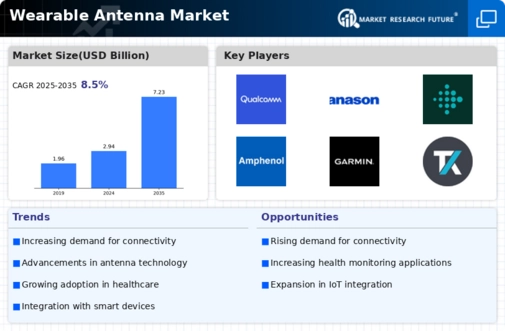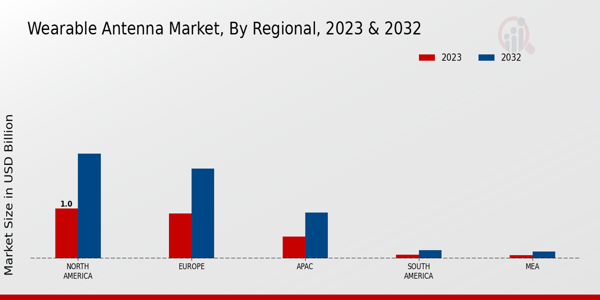Market Growth Projections
The Global Wearable Antenna Market Industry is poised for substantial growth, with projections indicating an increase from 2.94 USD Billion in 2024 to 7.23 USD Billion by 2035. This growth trajectory reflects a compound annual growth rate (CAGR) of 8.52% from 2025 to 2035. The anticipated expansion is driven by various factors, including advancements in technology, rising health consciousness, and the increasing integration of wearables in daily life. As the market evolves, it is expected to attract significant investments, fostering innovation and the development of new applications across diverse sectors.
Rising Adoption of IoT Devices
The proliferation of Internet of Things (IoT) devices is a key driver for the Global Wearable Antenna Market Industry. As more consumers embrace smart technology, the need for effective communication between devices becomes critical. Wearable antennas play a pivotal role in ensuring reliable connectivity, which is essential for the functionality of IoT ecosystems. The market is expected to grow at a CAGR of 8.52% from 2025 to 2035, reflecting the increasing integration of wearables in everyday life. This trend suggests that as IoT adoption rises, the demand for advanced wearable antennas will likely follow suit, creating new opportunities for manufacturers.
Emergence of Smart Clothing and Textiles
The emergence of smart clothing and textiles is reshaping the Global Wearable Antenna Market Industry. These innovative products incorporate antennas into fabrics, enabling seamless connectivity and functionality. This trend is gaining traction in various sectors, including sports, fashion, and healthcare, where the integration of technology into clothing offers new possibilities. As consumers seek multifunctional apparel, the demand for wearable antennas embedded in textiles is likely to rise. This evolution suggests a shift in consumer preferences towards more integrated solutions, potentially driving significant growth in the market.
Growing Demand for Health Monitoring Devices
The increasing emphasis on health and fitness is driving the Global Wearable Antenna Market Industry. Wearable devices equipped with antennas facilitate real-time health monitoring, enabling users to track vital signs such as heart rate and blood pressure. This trend is particularly pronounced in regions with aging populations, where health management is paramount. The market is projected to reach 2.94 USD Billion in 2024, reflecting a robust demand for health-centric wearables. As consumers become more health-conscious, the integration of advanced antennas in these devices is likely to enhance connectivity and data transmission, further propelling market growth.
Increased Focus on Personal Safety and Security
The growing awareness of personal safety and security is driving the Global Wearable Antenna Market Industry. Wearable devices equipped with antennas are increasingly being utilized for safety applications, such as location tracking and emergency alerts. This trend is particularly evident in urban areas where personal safety concerns are heightened. The integration of advanced antennas enhances the reliability of these safety features, making wearables more appealing to consumers. As the market evolves, the focus on safety is expected to contribute to the overall growth, with projections indicating a substantial increase in market value over the coming years.
Advancements in Wireless Communication Technologies
Technological advancements in wireless communication are significantly influencing the Global Wearable Antenna Market Industry. Innovations such as 5G technology are enhancing the capabilities of wearable devices, allowing for faster data transfer and improved connectivity. This is particularly relevant as consumers increasingly seek devices that can seamlessly integrate with their digital lives. The anticipated growth from 2.94 USD Billion in 2024 to 7.23 USD Billion by 2035 indicates a strong market trajectory, driven by the demand for high-performance antennas. As manufacturers adopt cutting-edge technologies, the potential for new applications in various sectors, including healthcare and fitness, expands.














